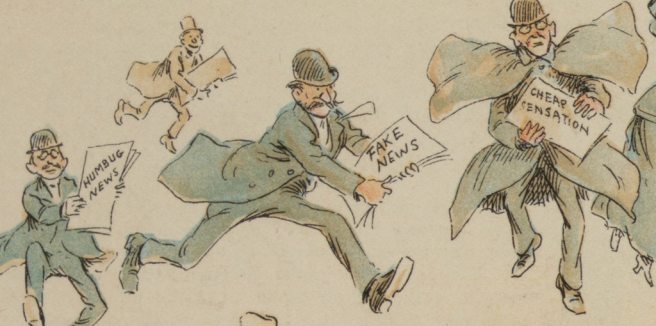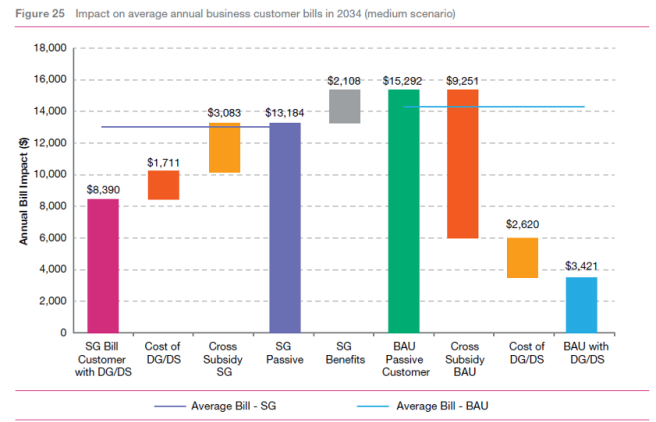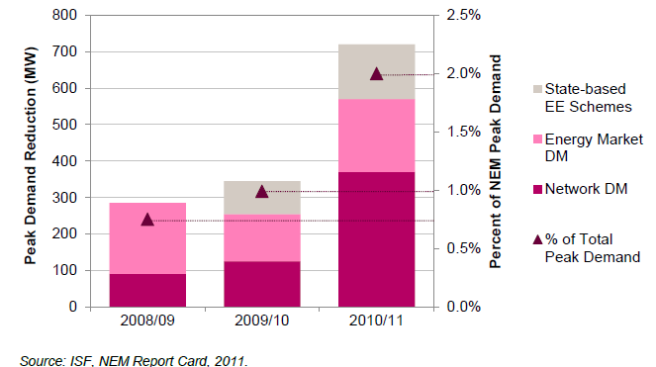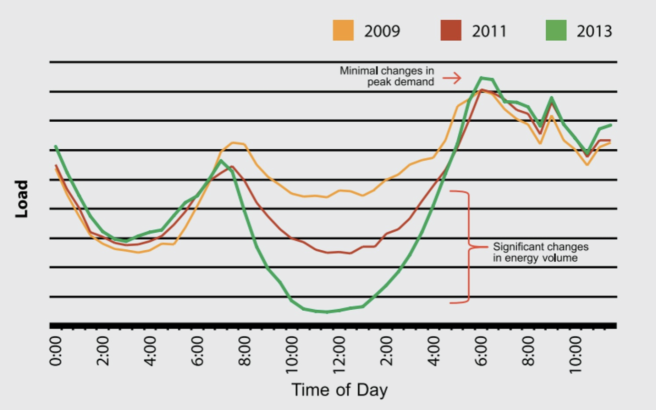The fake news hit Trent, Italy, on Easter Sunday, 1475. A two-and-a-half year-old child named Simonino had gone missing, and a Franciscan preacher, Bernardino da Feltre, gave a series of sermons claiming that the Jewish community had murdered the child, drained his blood and drunk it to celebrate Passover. The rumors spread fast. Before long de Feltre was claiming that the boy’s body had been found in the basement of a Jewish house. In response, the Bishop of Trent immediately ordered the city’s entire Jewish community arrested and tortured. Fifteen of them were found guilty and burnt at the stake. The story inspired surrounding communities to commit similar atrocities. Recognizing a false story, the papacy intervened and attempted to stop both the story and the murders. But the Bishop refused to meet the papal legate, and feeling threatened, simply spread more fake news stories about Jews. In the end, the popular fervor supporting anti-Semitic ‘blood libel’ stories made it impossible for the papacy to interfere with the church in Trent, who had Simonino canonized — Saint Simon — and attributed to him a hundred miracles. Today, historians have cataloged the fake stories of child-murdering, blood-drinking Jews, which have existed since the 12th C as part of the foundation of Antisemitism. And yet, one anti-Semitic website still claims the story is true and Simon is still a martyred saint.
Yet even the Scientific Revolution and the Enlightenment could not stop the flow of fake news. For example, in the years preceding the French Revolution, a cascade of pamphlets appeared in Paris exposing for the first time the details of the near-bankrupt government’s spectacular budget deficit. Each came from a separate political camp, and each contradicted the other with different numbers, blaming the deficit on different finance ministers. Eventually, through government leaks and more and more verifiable accounts, enough information was made public for readers to glean a general sense of state finance; but, like today, readers had to be both skeptical and skilled to figure out the truth. The use of the term ‘fake news’ has strayed from simply describing factually incorrect reporting. Some fake news never dies. But amid all the recent hand-wringing about fake news and how to deal with it, one fact seems to have been lost: fake news is not a new phenomenon. It has been around since news became a concept 500 years ago with the invention of print, a lot longer, in fact, than verified, ‘objective’ news, which emerged in force a little more than a century ago. From the start, fake news has tended to be sensationalist and extreme, designed to inflame passions and prejudices. And it has often provoked violence.

It is perhaps not so surprising to hear that the problem of ‘fake news’ – media outlets adopting sensationalism to the point of fantasy – is nothing new. Although, the peddling of public lies for political gain or financial profit can be found in most periods of history dating back to antiquity, it is in the late 19th-century phenomenon of ‘Yellow Journalism’ that it first seems to reach the widespread outcry and fever pitch of scandal familiar today. Although these days his name is somewhat synonymous with journalism of the highest standards, through association with the Pulitzer Prize established by provisions in his will, Joseph Pulitzer had a very different reputation while alive. After purchasing  The New York World and rapidly increasing circulation through the publication of sensationalist stories he earned the dubious honour of being the pioneer of tabloid journalism. He soon had a competitor in the field when his rival William Randolph Hearst acquired the The New York Journal.
The New York World and rapidly increasing circulation through the publication of sensationalist stories he earned the dubious honour of being the pioneer of tabloid journalism. He soon had a competitor in the field when his rival William Randolph Hearst acquired the The New York Journal.
The rivalry was fierce, each trying to out do each other with ever more sensational and salacious stories. At a meeting of prominent journalists it was claimed that due to their competition ‘the evil grew until publishers all over the country began to think that perhaps at heart the public might really prefer vulgarity’. The phenomenon can be seen to reach its most rampant heights, and most exemplary period, in the lead up to the Spanish-American War, a conflict dubbed ‘The Journal’s War’ due to Hearst’s immense influence in stoking the fires of anti-Spanish sentiment in the U.S. Much of the coverage by both the World and the Journal was tainted by unsubstantiated claims, sensationalist propaganda, and outright factual errors. When the USS Maine exploded and sank in Havana Harbor, huge headlines in the Journal blamed Spain with no evidence at all. The phrase, “remember the Maine, to Hell with Spain”, became a populist rousing call to action. The Spanish–American War began later that year.
As the disinformation age has continued to develop, science has not stood still. It has given us a more detailed picture than ever of the ways that disinformation hacks our truth judgments and what happens when we are subjected to repeated false claims. Research has found that even those of us who are intelligent, analytical and comfortable with ambiguity find statements more believable simply because we have heard them repeated. This phenomenon, known as the ‘illusory truth effect,’ was first documented in the 1970’s, but it is more relevant than ever in the era of fake news. Psychologists say that what makes repeated claims seem truer is their ‘fluency,’ meaning the cognitive ease with which we process a claim. Repeated claims are easier to represent and comprehend. For that reason, they just feel good. Our minds take this feeling as a cue that the claim is true.

Two additional ways disinformation hacks our truth judgments. One that is closely related to fluency and the good feelings it generates, is memory. The information and experiences stored in our memory are powerful weapons in the fight for truth. But, as with fluency, we take our memories as cues, not as the raw materials for forming well-considered judgments. We tend, in other words, to go with ‘near enough is good enough.’ We often accept claims as true when they only partially fit with what we know or remember. Additionally, we can fall prey to the ‘illusion of explanatory depth,’ a tendency to overestimate our knowledge and understanding of the issues in which we are interested. When we do, we are more likely to hold extreme beliefs and to accept fake news as true. Unfortunately, digital tools may be making our memories even weaker and less effective for judging truth. Search algorithms return content based on keywords, not truth. If you search ‘flat Earth,’ for example, Google dutifully returns photoshopped pictures for a ’50 meter wall of ice that keeps us from slipping off the planet.’ For this reason, relying on the internet as truth-on-demand rather than looking to our memories and acquired knowledge can backfire in serious ways.
On a winter afternoon in Helsinki, a group of students gathered to hear a lecture on a subject that is far from a staple in most community college curricula. Standing in front of the classroom at Espoo Adult Education Centre, the teacher worked his way through his PowerPoint presentation. A slide titled ‘Have you been hit by the Russian troll army?’ included a checklist of methods used to verify the content. Another slide, featuring a diagram of a Twitter profile page, explained how to identify bots: look for stock photos, assess the volume of posts per day, check for inconsistent translations and a lack of personal information. The lesson wrapped with a popular ‘deepfake’, highly realistic manipulated video of Barack Obama. The course is part of an anti-fake news initiative launched by Finland’s government in 2014, aimed at teaching residents, students, journalists and politicians how to counter false information designed to sow division. The initiative is just one layer of a multi-pronged, cross-sector approach the country is taking to prepare citizens of all ages for the complex digital landscape of today, and tomorrow. The Nordic country, which shares an 832-mile border with Russia, is acutely aware of what’s at stake if it doesn’t.

At the French-Finnish School of Helsinki, a bilingual state-run institution, that ethos is taken seriously. Classes are the embodiment of Finland’s critical thinking curriculum, which was revised in 2016 to prioritise the skills students need to spot the sort of disinformation that has clouded recent election campaigns in the US and across Europe. The school recently partnered with Finnish fact-checking agency Faktabaari (FactBar) to develop a digital literacy toolkit for elementary to high school students learning about the EU elections. It was presented to the expert group on media literacy and has been shared among member states. The exercises include examining claims found in YouTube videos and social media posts, comparing media bias in an array of different clickbait articles, probing how misinformation preys on readers’ emotions, and even getting students to try their hand at writing fake news stories themselves.
Perhaps the biggest sign that Finland is winning the war on fake news is the fact that other countries are seeking to copy its blueprint. Representatives from a slew of EU states, along with Singapore, have come to learn from Finland’s approach to the problem. The race is on to figure out a fix after authorities linked Russian groups to misinformation campaigns targeting Catalonia’s independence referendum and Brexit, as well as recent votes in France and Germany. Germany has already put a law in place to fine tech platforms that fail to remove obviously illegal hate speech, while France passed a law last year that bans fake news on the internet during election campaigns. Some critics have argued that both pieces of legislation jeopardise free speech.

Extracted from http://classic.austlii.edu.au/au/journals/UWALawRw/2012/7.pdf
The ‘quality press’ or ‘broadsheets’ have been for the most part professional, although occasional bad judgement is inevitable under the time-pressures inherent in news-reporting. Murdoch’s ‘The Australian’ has from time to time been accused of waging political campaigns in breach of reasonable expectations of media behavior. Much worse misbehavior has been apparent in the lower-grade press, which have been for many years subject to the pejorative label of ‘tabloid’, [e.g. The NT News]. Meanwhile, the broadcast media, particularly television ‘news’, has become cavalier in its pursuit of video that will stimulate viewer interest. To justify their behavior, media outlets continue to use the term ‘journalism’ not only in its real sense, but also to refer to the pursuit of ‘sensational trivia’, frequently about people, which is more reasonably described as ‘voyeurnalism’.
The term ‘the press’ originally referred to journalism in print media, and the term ‘the fourth estate’ was initially used as a positive reference to its role in political processes. Media organisations whose origins were in ‘the press’ have migrated to new media as opportunities arose. In Australia, the large newspaper groups own or have significant interests in radio stations and television channels. During the late 1990’s, as the Internet became widely available, they also quickly moved into networked media, particularly in the form of web-sites that operate as adjuncts to their print operations [e.g. SKYNews]. Competition for content and for customer attention has greatly intensified, as media organisations moved onto one another’s turf, and as formal and informal newcomers emerged. The competition for revenue has been even more vicious. The Internet arrived without turnstiles. The ‘free as in beer’ ethos took hold, and it has proven very challenging for media organisations to sustain their subscriptions revenue. In 2011, News Corp began erecting a ‘paywall’, hoping to join the few strongly-reputed organisations that have been successful in charging for access [notably The Wall Street Journal, The Financial Times, The Economist and Nature]. Yet worse than the leakage of subscription revenue has been the hemorrhage of advertising revenue. Networked media gave rise to serious challenges to the dominance of print media over classified advertising. Meanwhile, in the display advertising area, not only is the available revenue now spread more thinly over more channels, resulting in less to each media organisation, but the business of advertising in networked media is now dominated by a single organisation, which extracts far higher margins than did the value-chains that have long existed in print and broadcast advertising.
Some of the worst examples of privacy invasions are available at http://classic.austlii.edu.au/au/journals/UWALawRw/2012/7.pdf Pp 9 -14.
[At the foundation of most fake news is the the media’s intrusions into the subjects privacy]. However, privacy-abusive information-collection behavior is protected unless the resulting material is published. Unless the media’s actions can be shown by the complainant to be completely beyond the pale, ACMA won’t even issue a warning, let alone take any actual protective action. The sum total of the guidance ACMA provides in relation to vulnerable people is that “[s]pecial care must be taken” [p. 4]. ACMA’s new guidelines give carte blanche to broadcasters to be as objectionable as they like in the pursuit of news, and to publish personal data that is unnecessary to the story, and that may cause the individuals concerned substantial offence or distress. Reflecting the low standards to which ‘The Australian’ has fallen on media freedoms issues, a News Ltd sub-editor contrived to make ACMA’s highly media friendly guidelines appear like an attack on media freedoms.
The concerns about media practices, particularly among Murdoch companies, spread to Australia, to the extent that the then CEO of the Australian arm, Neil Hartigan, felt constrained to issue a succession of announcements distancing Murdoch’s Australian newspapers from the practice of ‘phone hacking’. The claims about professionalism would have been stronger if anyone had been able to locate the Code of Conduct [to which he referred]. Adding to the controversies, in early September 2011, a 40,000-word analysis was published by a political scientist, which was highly critical of News Ltd’s behavior and its effect on Australian democracy.
Manne R. (2011) ‘Bad News: Murdoch’s Australian and the Shaping of the Nation’ Quarterly Essay 43, September 2011, In Bad News, Robert Manne investigates Murdoch’s lead political voice here, The Australian newspaper, and how it shapes debate. Since 2002, under the editorship of Chris Mitchell, the Australian has come to see itself as judge, jury and would-be executioner of leaders and policies. Is this a dangerous case of power without responsibility? In a series of devastating case studies, Manne examines the paper’s campaigns against the Rudd Government and more recently the Greens, its climate change coverage and its ruthless pursuit of its enemies and critics. Manne also considers the standards of the paper and its influence more generally. This essay is part deep analysis and part vivid portrait of what happens when a newspaper goes rogue.”
During 2009-11, News Ltd outlets had been publishing ongoing, intemperate attacks on various aspects of the federal Government’s policies. One explanation was that “[The then Editor-in-Chief of ‘The Australian’, Chris Mitchell] has inculcated a view [at the newspaper] that they are there not only to critique and oversee the government, [but also that] it is their role to dictate policy shifts, that they are the true Opposition”.
Newspapers have a long history of editorializing on the eve of an election, giving readers the view of the editor-in-chief on which party would be best to lead the country. The editorial view is not supposed to influence a masthead’s coverage of the news, however, in 2015, the NT News published a strong editorial arguing that the Abbott-Turnbull-Morrison government had ‘largely failed to deliver for the Territory’ and urging people to vote for Labor’s Luke Gosling and Warren Snowdon to retain their seats of Solomon and Lingiari. “The shocking levels of abuse and neglect of Aboriginal children wasn’t even on their radar until this newspaper led a relentless campaign on the issue, eventually leading to then Prime Minister Malcolm Turnbull visiting Tennant Creek,” the NT News said. “Since he has taken over as PM, Morrison has shown little to no interest in this issue which seriously threatens the future prosperity of the Northern Territory and Australia.” The Australian, and stablemates the Daily Telegraph, the Herald Sun, the Courier Mail and the Advertiser all backed the Coalition.
So, in view of his position at number 1 in the NT News list of most powerful Territorians, it will be interesting to see how Matt Williams treats Terry Mills in his attempt to create a third force in Territory politics. In view of the fact that very few have any idea of what criteria are use to determine ‘the list’ it is difficult to predict the biases that will, no doubt, be repeated over and over in the months before August. Because the NT News is the only newspaper and, with the exception of the ABC, the only online source of information pertaining to politics in the NT, exceptional weight of opinion will be brought to bear on the voting public to adhere to the editors opinion, regardless of how poorly it reflects readers concerns.

The former chief minister and Member for Blain is an extremely dangerous species. He’s dangerous because no one really knows what influence his Territory Alliance party will have on the 2020 election. Will they win zero seats, will they win one seat. maybe two or will they win six or seven? It’s the million dollar question leading into what is one of the most intriguing elections in our history. Mills has gathered some impressive candidates and with so many people disenfranchised with the major parties; his party could be a force to be reckoned with. The problem he has right now is they haven’t unveiled any policies but that will come in time. He claims his party will operate on ‘consensus’ politics which is a dangerous position to be in. As much as he might think it, you can not and will not please everyone in politics. You have to make a stand at some stage on big issues. Mills seems deaf to the reasons why he was rolled as chief minister in 2013 but many Territorians haven’t forgotten. At the same time, Mills has a small army of supporters in the Territory but how big that army is remains to be seen. Mills‘ party will no doubt take votes away from the CLP in the 2020 election and he will split the conservative vote. Will that be enough for Labor to get over the line again? Or will his influence mean he will decide who wins power in a conservative coalition government? Either way. Mills is both our No.1 Most Powerful and our No.1 Most Dangerous.


 On Saturday 14 December the Empty News published two full pages of opinion centered on renewable energy, one by Ian Satchwell and the other by regular contributor Matt Cunningham from skyNEWS. The first is principal of Airlie Asia and former director of the Department of Chief Minister. The latter is simply a mouthpiece for Rupert, repeating whatever he is told is the “message” of the day.
On Saturday 14 December the Empty News published two full pages of opinion centered on renewable energy, one by Ian Satchwell and the other by regular contributor Matt Cunningham from skyNEWS. The first is principal of Airlie Asia and former director of the Department of Chief Minister. The latter is simply a mouthpiece for Rupert, repeating whatever he is told is the “message” of the day.





